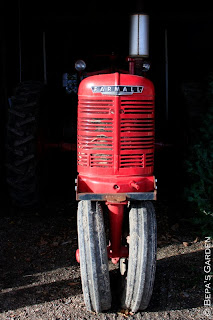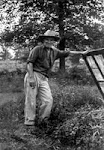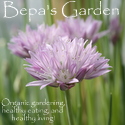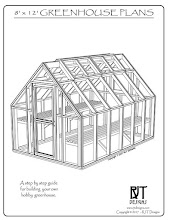I've mentioned several times that my passion for gardening comes from time spent with my grandparents when I was growing up. I feel my strong connection to food and farming has been instilled in me at a young age, by working side by side in the greenhouse with my grandfather, and cooking in the kitchen with my grandmother.
Some of the fondest memories I have are of picking raspberries in the summer with my grandfather. Putting the ripe berries in pint containers to sell to the small grocery store in town, and setting aside the overripe ones so my grandmother could brew up a batch of her sweet raspberry syrup which she used to make the most delicious raspberry juice.
I also remember the smell of my grandfather's greenhouse, the tropical aroma of soil and plants in the humid air. I remember his prized lemon tree with lemons the size of grapefruits and the bird of paradise plant, with the most beautiful flowers, growing in the corner.
I can remember being nervous about starting a new grade in elementary school, scared because of rumors I heard about my teacher being really mean. To help me, Bepa cut a flower from his bird of paradise plant and told me to give it to my teacher on the first day. He told me to extend a gesture of kindness and everything would be okay. Turns out the teacher was really nice. Those flowers got me through many stressful situations.
My grandparents both passed away when I was about 14, but I always remembered working in the greenhouse and that beautiful bird of paradise plant. About 10 years ago I purchases a small plant to keep in my office. I was always hoping to get it to flower, but despite it growing over 4' tall, it never did. This past summer, my cousin Patty, who I haven't talked to in a really long time, surprised me by dropping off this gift with a note:
I was beyond thrilled to have an offspring from Bepa's original plant!
This gift meant so much to me.
I put the plant in my greenhouse over the summer, not sure if it would survive. I left it out there during the 100 degree days, and despite a few leaves dying, it seemed to be holding on. In September, I decided to swap it with the one in my office that never flowered. I re-potted it into a bigger pot and noticed that a large root had formed. There was hope that this plant would make it!
A few days later I noticed a new stalk coming up, but it just looked like another new leaf. I was very optimistic about the plant flowering because they are tropical plants, usually flowering in the high heat and humidity of summer. It was now October and we already had our first frost and daytime temps were dipping into the upper 40's.
By the beginning of November that stalk that I thought was a leaf started to take on a different shape. It began bending about 8" from the end and started to have light shades of orange and red. I was now positive that this was a flower! The thought of finally getting a flower from a plant that was divided just 6 months earlier was astounding. Over the next couple of days I watched with anticipation as the colors began to intensify as it looked like it was about to burst open.
Last night the pod finally opened! My wife and I both stood there in amazement and watched as the flower slowly emerged! I couldn't believe that this plant that came from Bepa's original was actually flowering!
This plant sits on my desk in my office next to a picture of Bepa that hangs on my wall. I always feel that he is watching over me, inspiring me and guiding me to move forward along my journey to farm.
My wife and I both said it would be funny if the plant flowered on Bepa's birthday. This morning we looked through our genealogy information and found out that Bepa's birthday was November 3rd, the day it started to flower! We both had goosebumps!
I always feel the presence of Bepa with me, but now I know for sure that he is there, watching over me and inspiring me to live the life I dream of.
~Rob~
I can remember being nervous about starting a new grade in elementary school, scared because of rumors I heard about my teacher being really mean. To help me, Bepa cut a flower from his bird of paradise plant and told me to give it to my teacher on the first day. He told me to extend a gesture of kindness and everything would be okay. Turns out the teacher was really nice. Those flowers got me through many stressful situations.
My grandparents both passed away when I was about 14, but I always remembered working in the greenhouse and that beautiful bird of paradise plant. About 10 years ago I purchases a small plant to keep in my office. I was always hoping to get it to flower, but despite it growing over 4' tall, it never did. This past summer, my cousin Patty, who I haven't talked to in a really long time, surprised me by dropping off this gift with a note:
I was beyond thrilled to have an offspring from Bepa's original plant!
This gift meant so much to me.
I put the plant in my greenhouse over the summer, not sure if it would survive. I left it out there during the 100 degree days, and despite a few leaves dying, it seemed to be holding on. In September, I decided to swap it with the one in my office that never flowered. I re-potted it into a bigger pot and noticed that a large root had formed. There was hope that this plant would make it!
A few days later I noticed a new stalk coming up, but it just looked like another new leaf. I was very optimistic about the plant flowering because they are tropical plants, usually flowering in the high heat and humidity of summer. It was now October and we already had our first frost and daytime temps were dipping into the upper 40's.
By the beginning of November that stalk that I thought was a leaf started to take on a different shape. It began bending about 8" from the end and started to have light shades of orange and red. I was now positive that this was a flower! The thought of finally getting a flower from a plant that was divided just 6 months earlier was astounding. Over the next couple of days I watched with anticipation as the colors began to intensify as it looked like it was about to burst open.
Last night the pod finally opened! My wife and I both stood there in amazement and watched as the flower slowly emerged! I couldn't believe that this plant that came from Bepa's original was actually flowering!
This plant sits on my desk in my office next to a picture of Bepa that hangs on my wall. I always feel that he is watching over me, inspiring me and guiding me to move forward along my journey to farm.
My wife and I both said it would be funny if the plant flowered on Bepa's birthday. This morning we looked through our genealogy information and found out that Bepa's birthday was November 3rd, the day it started to flower! We both had goosebumps!
I always feel the presence of Bepa with me, but now I know for sure that he is there, watching over me and inspiring me to live the life I dream of.
~Rob~




















































































